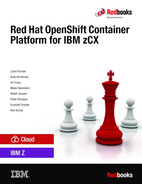

Use case 3: Migrating a solution from zCX Docker to Red Hat OpenShift in zCX
In this chapter, we discuss the differences between Docker and Red Hat OpenShift. We also discuss why you might want to migrate a solution from zCX Docker to Red Hat OpenShift in zCX.
4.1 Differences between Docker and Red Hat OpenShift
In this section, the differences between Docker and Red Hat OpenShift are explained to understand the driving reasons to move from zCX Docker to zCX for OpenShift and when a company might consider doing so.
Docker
Docker is a container solution with which the can user build, deploy, and manage containers. By using Docker, the user has a virtualized environment that can be deployed quickly and with high portability to reduce the time to market.
Some of the main advantages of Docker include the following examples:
•Modularity: Different components of an application run in different containers, so you can easily update components.
•Layers and versions: Images consist of layers. These layers are stacked on top of each other to form the container file system, which changes only the layers that are needed if an update occurs.
•Application Isolation: Containers run in isolated environments. Each container is independent from the rest.
•Rapid Deployment: Docker-based containers can reduce deployments to seconds, which is significantly faster than virtual machines.
•Portability: Different containers can be quickly deployed on different environments and multiple architectures.
•Cost Savings: Dramatically reduces infrastructure resources. Fewer resources are necessary to run the same application.
Although Docker is the most common solution, and it is the name that is most referred to when discussing containers, it is not the only container solution. Many other companies also provide container software that is unrelated to Docker, such as Podman, LXD, or CRI-O.
Red Hat OpenShift
Red Hat OpenShift is a container orchestration platform that is based on Kubernetes. It eases the building, deployment, management, and scaling of applications. It is commonly seen as an alternative to Docker or containers, but it is a platform to handle containers at scale. It also is used to be built on top of Docker (now it runs on CRI-O).
Some of the advantages that Red Hat OpenShift provides include the following examples:
•Intelligent Scheduler: Automatically schedule containers to the best possible host to optimize the use of resources.
•Scaling: Scale containers automatically if more throughput is needed.
•DevOps: Enables productivity by simplifying CI/CD processes.
•Container monitorization: Includes a full stack for monitorization of the resources and applications of the platform.
•Multi-tenant: Access to the different applications and resources is controlled by the platform to integrate multiple tenants into the platform.
•Security: Built-in security with default execution policies that prevent applications to be run as root.
|
Note: For more information about Red Hat OpenShift, see this web page.
|
Conclusion
Docker and Red Hat OpenShift differ in terms of the features that they provide. When it comes to the use of the best tool for a zCX deployment, these features must be analyzed with the needs of each application at the forefront of consideration.
Docker often is used in smaller environments that do not require managing many containers because it is easier and faster to implement. For specific use cases on zCX, such as small applications, and open source single containers, Docker is a clear candidate as a deployment environment of a company’s application.
However, when an application is bigger or even multiple applications must be managed from a single platform, a need often exists for Red Hat OpenShift because it gives the user the ability to keep all of these containers active, implement high availability, implement DevOps tools, and so on.
..................Content has been hidden....................
You can't read the all page of ebook, please click here login for view all page.
